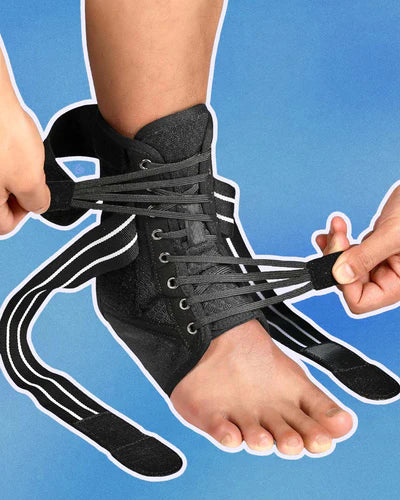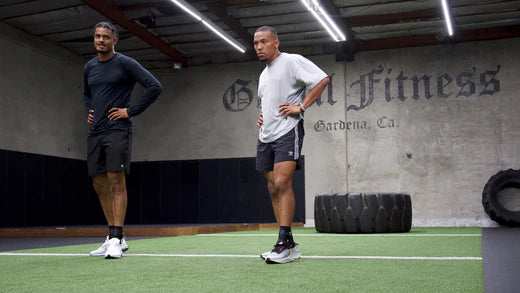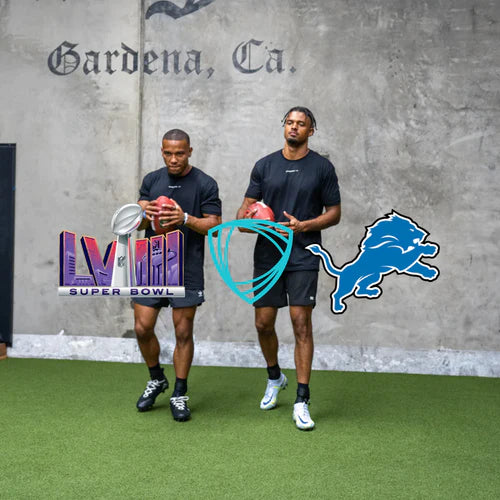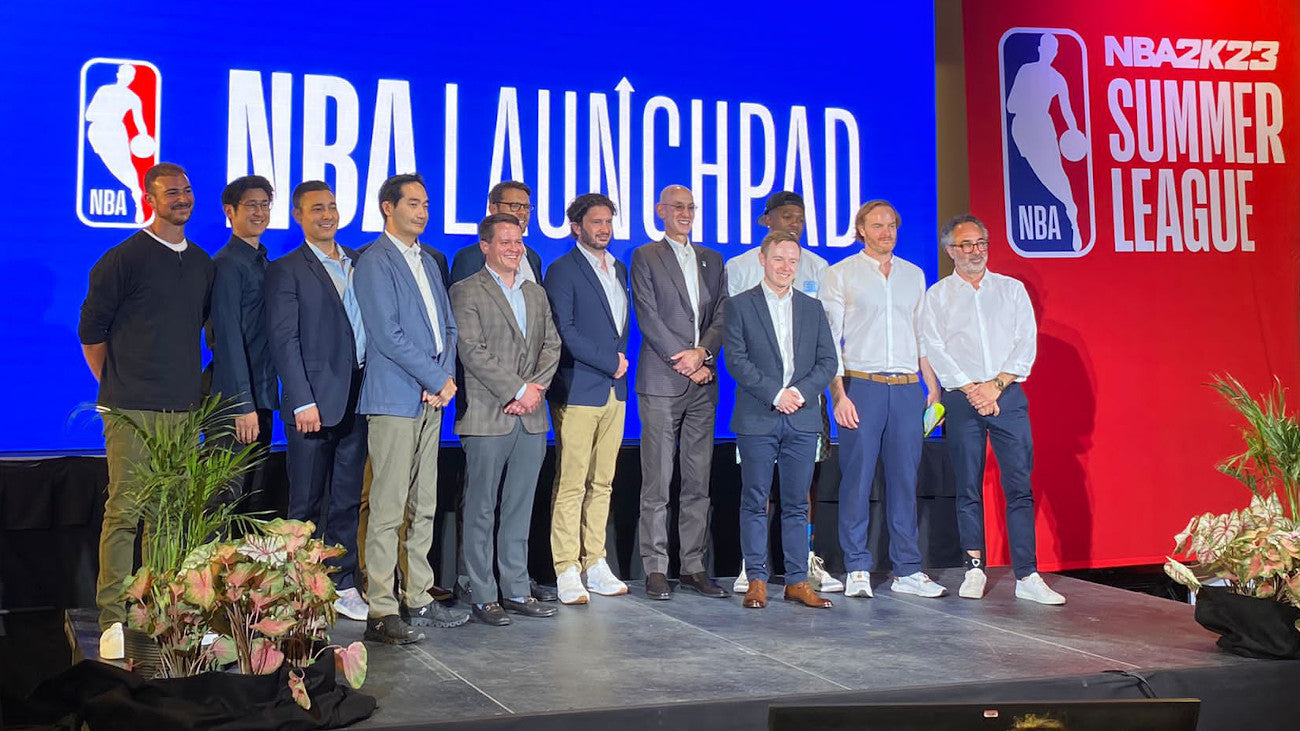Even rec-league all-stars live in fear of the dreaded ankle sprain that will end their city-league career. But knowing how to find the best ankle brace to treat and prevent can keep your injury risk at a minimum.
Twisted your ankle during a rec league basketball game?
We've all been there. And while turning your ankle can make you feel a little geriatric, the indignity of wearing a pair of ankle braces while you hoop is a small price to pay for anyone with a history of ankle injuries.
If this doesn’t sound familiar, it probably at least sends a chill up your spine. Whether you play competitive high school, college, or pro basketball or are strictly a “do-it-for-the-postgame-happy-hour” type, ankle injuries are one of the active guy’s greatest fears. As the glory days of your youthful athletic superstardom fade into distant, soft-lit, and wildly-embellished memories, you may find yourself looking to fill that gaping hole in your life with a regular pickup basketball game (or a co-rec volleyball league or a flag football tournament, or whatever).
Coming out of retirement at this stage in life is no joke, and working ankles are pretty important when it comes to physical fitness, so finding the right gear to protect yourself is crucial.
Ankle injuries are way too common
The ankle sprain is a grimly common injury — the American Orthopaedic Foot & Ankle Society estimates 25,000 people do it every day, a statistic that just caused me to wince audibly. Mild sprains might be sore for a day or two before clearing up on their own. Severe ankle sprains, on the other hand, can leave you sidelined for weeks or months at a time. After my recent sprain, I used crutches and a walking boot for weeks before I could even stand on two feet.
The good news, my fellow weekend warrior, is that things don't have to be this way. We have ample evidence pointing to the effectiveness of ankle braces in protecting your lower extremities. Braces are especially effective at supporting and stabilizing the joint during excessive turning or twisting.
But before resigning yourself to a season of clunky lace-up ankle braces and high tops, hold on! The truth is, lace-up ankle braces might be doing more harm than good.

The history behind the ankle brace lace-up contraption
It's ironic, really, that these clunky contraptions we call lace-up braces have such a storied past. Believe it or not, their history goes all the way back to the 1800s, when they strutted onto the scene under the rather… interesting… title of 'ankle corsets.' Yes, just like the waist-cinching garments women were forced into, these early ankle braces aimed to constrict movement by synching, demonstrating our limited understanding of injuries, let alone biomechanics.
Now imagine sprinting with a full corset around your ankle. Think about it: those endless laces and bulky straps meant to support often stifle natural movement. That's essentially what you're doing with many traditional braces. They offer limited, one-size-fits-all support that fails to adapt to the nuanced demands of your activities.
The result? A compromised athletic experience and weak ankles. You sacrifice agility, limit your range of motion, and, worst of all, mask underlying weaknesses. That's right, and ankle lace-up braces can actually prolong your recovery by preventing your muscles and ligaments from relearning their proper roles in stabilizing your ankle.
Thankfully, we've come a long way, and modern materials, along with scientific advancements, offer much better options when it comes to treating and preventing injuries. Maintaining biomechanic integrity is crucial to effectively treat an ankle sprain. That’s why modern ankle supports and braces prioritize natural movement, mobility, and adaptability.

What makes The BetterGuard different makes it better
So, what's the alternative? Enter The BetterGuard ankle brace, a huge step forward in ankle support. Forget the cumbersome lacing systems and restrictive straps. The BetterGuard employs cutting-edge biomechanical technology to provide dynamic, reactive support that moves with you, not against you.

Here's why you should lace-up with a pair of BetterGuard ankle braces
If you’re wondering whether The BetterGuard can withstand copious amounts of dribbling at your local rec center, I can tell you with certainty, my friend, it can. The brace was actually designed in partnership with the NBA Launchpad, the NBA’s initiative to source, evaluate, and pilot emerging technologies to advance the league’s top basketball and business priorities. In 2022, Betterguards was selected to focus on injury prevention and recovery technology.
According to Hashtag Basketball’s database, which tracks the causes of the 4,000-plus times NBA players have missed games since 2010, only one injury has been a more common culprit than “sprained right ankle”: sprained left ankle. Over that time, ankle injuries cost players a cumulative 15 years’ worth of action. In any season, 25% of NBAers will suffer an ankle sprain.

Pro athletes trust The BetterGuard
NBA players are adopting the product at a surprising rate. Where most products require years of extensive trialing and testing, The BetterGuard has been adopted by several NBA players in its first year since launching at the NBA Summer League in 2023.
“After struggling with tape and other ankle braces for years, I wanted to find the lightest-weight brace that would still give me the support I need and let me still move like I want to,” said Franz Wagner, a budding superstar forward with the Orlando Magic. “I’m embracing the minimalist approach of the BetterGuard because it’s actually much better for us to have freedom of movement in an ankle brace vs. wearing the enormous ankle braces people used to play in before.”

What makes The BetterGuard different:
- Foot & Ankle Mobility: Unlike rigid braces, The BetterGuard's lightweight, breathable fabric allows for a normal range of motion. Jump, pivot, and cut with complete confidence, knowing your ankle is protected without sacrificing performance.
- Reactive Ankle Support: Forget static, one-dimensional support. The BetterGuard's intelligent materials react to your every movement, providing targeted compression and support only when and where you need it most. This dynamic approach mimics the natural way your muscles and ligaments stabilize your ankle, leading to faster recovery and improved proprioception.
- No More Lacing: Forget the frustration of tangled laces and cumbersome straps. The BetterGuard's sleek, slip-on design takes seconds to put on and adjust, ensuring a comfortable, secure fit even under an athletic shoe.
Is a lace-up ankle brace better than nothing?
Now, you might be asking, "Isn't some ankle support better than none?" While traditional braces do offer a certain level of protection, they might come at the cost of reduced proprioception and weakened muscles. The full impact of lace-up bracing on body kinematics remains unclear, but many sports medicine experts believe it could increase your risk of injuries as your leg compensates for the restricted movement.
The BetterGuard, on the other hand, aims to maintain the regular movement pattern by allowing the highest mobility, which can support fast healing and strengthening. By regaining mobility in muscles and ligaments, you can strengthen them over time, leading to lasting stability and a decreased risk of re-injury.
There's no perfect solution
To be clear, there is no perfect solution to prevent ALL ankle injuries. The BetterGuard can help prevent a lot of ankle injuries on its own, but it’s not bulletproof. Still, an ankle will occasionally give out, and I'll briefly collapse in a heap, just like old times. But when that happens, The BetterGuard faithfully turns what could potentially be a nasty turn into a less severe injury.
And, I can't look you in the eyes and tell you an ankle brace is a stylish accessory. Your fears that embracing prophylactic athletic equipment will make you look like your grandpa rolling up to the racquetball club are well-founded.
But you know what's worse than looking like the old guy at the racquetball club? Being the guy who has to limp sheepishly into the big meeting wearing a cheap lace-up ankle brace he bought last night at CVS. Don't be the guy who comes to work wearing socks and sandals – two sizes too big – because the brace you got won’t fit inside your sneakers.
Yes, it's worth the investment
Whether you're a weekend warrior or a competitive athlete, wearing a brace is a minor indignity that will spare you from much more significant ones and is well worth the investment. Don't get suckered into lace-up ankle braces that might do you more harm than good. Embrace the freedom and confidence of dynamic, reactive support with The BetterGuard. Get back to the activities you love, knowing your ankles are protected and stronger than ever.
Because, after all, your ankles deserve better than being held back by a clunky relic of the past.






